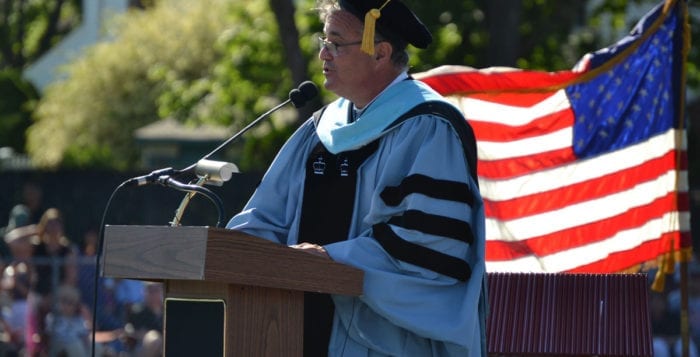By Leah Chiappino
In light of graduation season, Mount Sinai valedictorian Isaac Kisten and salutatorian Kenneth Wei have taken the time to reflect on their hopes for the future as well as their journeys to the success they have attained thus far in school.
Kisten has a final GPA of 104.28 and plans to attend the Stern School of Business at New York University as a finance major. He stated that he also hopes to study social entrepreneurship in order to “leverage the use of business to benefit the community in some way.”
At Mount Sinai, he took ten AP courses and earned the AP Scholar with Distinction award. Kisten stayed immersed in extracurriculars at Mount Sinai as the Future Business Leaders of America president and the National Honor Society treasurer. He volunteered for Habitat for Humanity, March of Dimes and the Ronald McDonald House, and worked as the Center Youth Group student leader.
To boot, he played varsity basketball and won several awards for his performance, such as Basketball All-County Academic and first place at the AICPA National Bank On It tournament. He was named Infant Jesus Basketball All-Star.
Kisten commended his family for his accomplishments.
“They always had confidence in me and my abilities,” he said. “They motivated and guided me when I needed direction.”
The Kisten family first moved to Mount Sinai from Queens in 2007, a decision Kisten has nothing but positive things to say about.
“These past 12 years have been amazing,” the valedictorian said. “This school is unparalleled in preparation and opportunities offered to all students. The community of Mount Sinai has been extremely welcoming.”
He added equally high esteem and appreciation for his teachers.
“Being valedictorian is more of a testament of how exceptional all my teachers have been,” he said. “I simply listened to all of their advice and teaching and success came easy.”
Kisten did not abstain from the opportunity to thank his friends and regarded the school’s senior trip to Disney as his favorite high school memory, citing the “countless memories” that were made in just a few days.
As far as advice to future seniors, Kisten said to “pay attention to the advice of those who went before us. Parents, teachers and all of those who have had more life experiences than us offer guidance that can be the key to success. Always keep in mind the small community of Mount Sinai. It gave us 12-plus years of our lives that we could not find anywhere else.”
Wei earned a final GPA of 104.11, and will be attending MIT as a bioengineering major, with hopes of working in the research field. His extracurriculars included Athletes Helping Athletes Club and Student Council president, as well as playing the flute and piano in the music department.
His favorite memories from high school consist of his tenure running track and field. He joked that his most memorable experience in the sport was splitting a cantaloupe between his legs at the state championships. His skills exceed far beyond that, as in the 2019 indoor track and field season he earned the U.S. #1 Mark for the long jump, was recognized three times as an All- American track star and holds the state record in the sixty meter hurdles. He also competed with professional and Division 1 collegiate athletes at the Toyota USATF indoor championships.
Wei took 11 AP courses, but his favorite class at Mount Sinai was a ceramics course taught by Eric Giorlando, who doubles as his track coach. Wei praised Giorlando, calling him a “mentor to me over the past four years. He’s taught me a lot and I would like to thank him for all he has done for me.”
Wei’s advice to future seniors was to relax during the college admission process, and not to focus on the immense stress he said students are put through.
“Nine times out of ten you are going to be happy where you end up regardless,’’ he said. “If there is an extracurricular you want to take, but you are juggling a big STEM class your senior year, go for the extracurricular. Just
have fun.”























